
Echium plantagineum, commonly known as purple viper's-bugloss, Paterson's curse or Salvation Jane, is a species of the genus Echium native to western and southern Europe, northern Africa, and southwestern Asia. It has also been introduced to Australia, South Africa, and United States, where it is an invasive weed. Due to a high concentration of pyrrolizidine alkaloids, it is poisonous to grazing livestock, especially those with simple digestive systems, such as horses.

Cryptobiosis or anabiosis is a metabolic state in extremophilic organisms in response to adverse environmental conditions such as desiccation, freezing, and oxygen deficiency. In the cryptobiotic state, all measurable metabolic processes stop, preventing reproduction, development, and repair. When environmental conditions return to being hospitable, the organism will return to its metabolic state of life as it was prior to cryptobiosis.
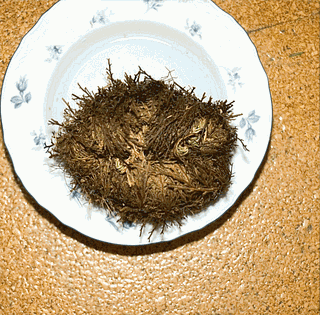
A resurrection plant is any poikilohydric plant that can survive extreme dehydration, even over months or years.
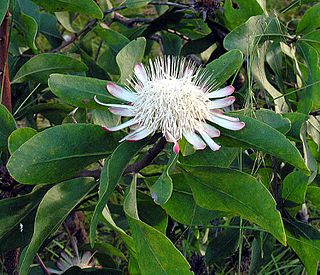
Protea gaguedi is a species of tree which belongs to the genus Protea.

Linderniaceae is a family of flowering plants in the order Lamiales, which consists of about 25 genera and 265 species occurring worldwide. Vandellia micrantha is eaten in Laos, but tastes bitter. Best known are the wishbone flowers Torenia fournieri and Torenia thouarsii, which are used as bedding plants, especially in the tropics. Micranthemum is sold as an aquarium plant under the name 'baby tears'.
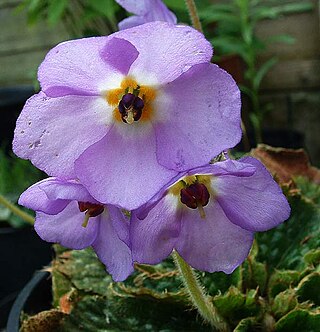
Ramonda serbica, also known as Serbian ramonda and Serbian phoenix flower, is a species in the family Gesneriaceae and are one of the four plants in the Ramonda genus. It was first discovered in 1874 near Niš, Serbia, by the Serbian botanist Josif Pančić. The Serbian ramonda is notable for its distinctive desiccation tolerance.
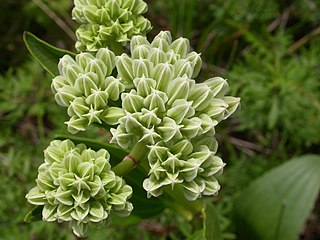
Arnoglossum plantagineum also known as tuberous Indian-plantain, groovestem Indian plantain or prairie Indian plantain, is a North American species of Arnoglossum in the sunflower family. The Latin specific epithet plantagineum refers to the leaves of the plant which are similar to those of a plantain.

Pechuel-loeschea, is a monotypic genus of African plants in the elecampane tribe within the sunflower family, and named after the German plant collector and geographer Eduard Pechuël-Loesche (1840-1913).

Englerophytum is a group of trees in the family Sapotaceae described as a genus in 1914.

Tinnea (sunbells) is a genus of plants in the family Lamiaceae first described in 1867. It is native to sub-Saharan Africa. It was named in honour of the Dutch explorer Alexine Tinne.
- Tinnea aethiopicaKotschy ex Hook.f. - widespread from Mali to Somalia south to Mozambique; naturalized in Trinidad & Tobago
- Tinnea antiscorbuticaWelw. - DRC, Zambia, Angola
- Tinnea apiculataRobyns & Lebrun - eastern Africa from Rwanda to Mozambique
- Tinnea barbataVollesen - Eswatini, northern South Africa
- Tinnea barteriGürke - western Africa
- Tinnea benguellensisGürke - Angola
- Tinnea coeruleaGürke - DRC, Zambia, Angola
- Tinnea eriocalyxWelw. - DRC, Angola, Botswana, Namibia
- Tinnea galpiniiBriq. - Eswatini, Mozambique, South Africa
- Tinnea gossweileriRobyns & Lebrun - Angola
- Tinnea gracilisGürke - Tanzania to Zambia
- Tinnea mirabilis(Bullock) Vollesen - Tanzania
- Tinnea physalisE.A.Bruce - Tanzania
- Tinnea platyphyllaBriq. - DRC
- Tinnea rhodesianaS.Moore - South Africa, Namibia, Zimbabwe, Zambia, Angola, Mozambique
- Tinnea somalensisGürke ex Chiov. - Ethiopia
- Tinnea vesiculosaGürke - Tanzania, Malawi
- Tinnea vestitaBaker - Zimbabwe, Zambia, Angola, Botswana
- Tinnea zambesiacaBaker - Zimbabwe, Zambia, Malawi, Mozambique

Marie Prins is a South African botanist.

Aeollanthus (rocksage) is a genus in the mint family, Lamiaceae. All the species are native to Africa.
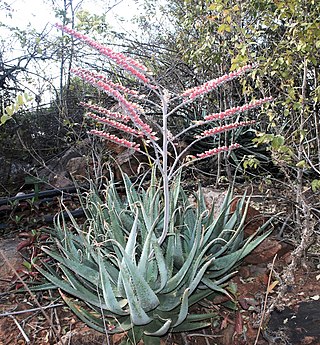
Aloe globuligemma, commonly known as the witchdoctor's aloe, is a species of flowering plant in the family Asphodelaceae. It is native to southern Africa where it occurs in semi-desert and dry bushland. It is an evergreen, succulent, perennial plant. The plant forms large, dense clumps. It is harvested from the wild for local medicinal use.
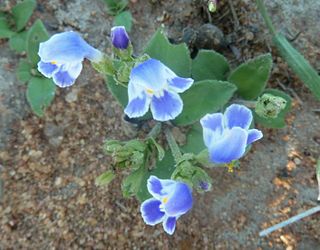
Craterostigma is a genus of shrub-like flowering plants in the family Linderniaceae, found in Africa, Madagascar, Socotra, the Arabian Peninsula, the Indian Subcontinent, Sri Lanka, China, Southeast Asia and Java. The best studied species is the resurrection plant Craterostigma plantagineum, known for its unique drought tolerance.

Gardenia volkensii, commonly known as bushveldt gardenia or Transvaal gardenia, is a species of plant in the family Rubiaceae native to southern Africa.

Pterodiscus is a genus of plant in the Pedaliaceae family comprising several species with a native range from Ethiopia to S. Africa. The range passes through the countries of Angola, Botswana, Ethiopia, Kenya, Mozambique, Namibia, Somalia, Sudan, Tanzania, Zambia and Zimbabwe. Plus it is found also within the Provinces of South Africa in Cape Provinces, Free State, KwaZulu-Natal and Northern Provinces.

Holubia is a monotypic genus of flowering plants belonging to the family Pedaliaceae. The only species is Holubia saccata.

Hewittia malabarica is a flowering plant in the monotypic genus HewittiaWight & Arn., belonging to the family Convolvulaceae and widespread throughout tropical Africa, Asia, and Polynesia. It is a climbing or prostrate perennial herb with slender stems and flowers that are pale yellow, cream, or white with a purple center, and large leaves that can be used as a cooked vegetable or used in folk medicine with the roots. The stems can be used to make ropes.
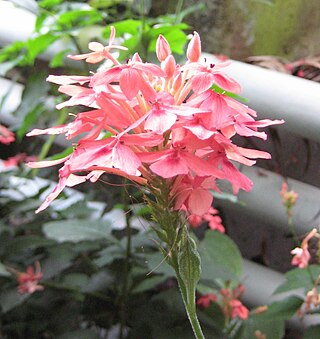
Ruspolia is a genus of flowering plants belonging to the family Acanthaceae.
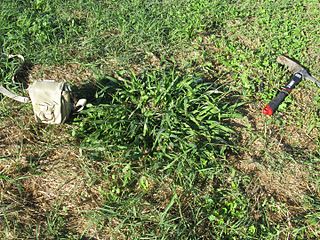
Urochloa trichopus, bushveld signal grass is a species of grass that is native to tropical and southern parts of Africa, Arabian Peninsula and western Madagascar.






















